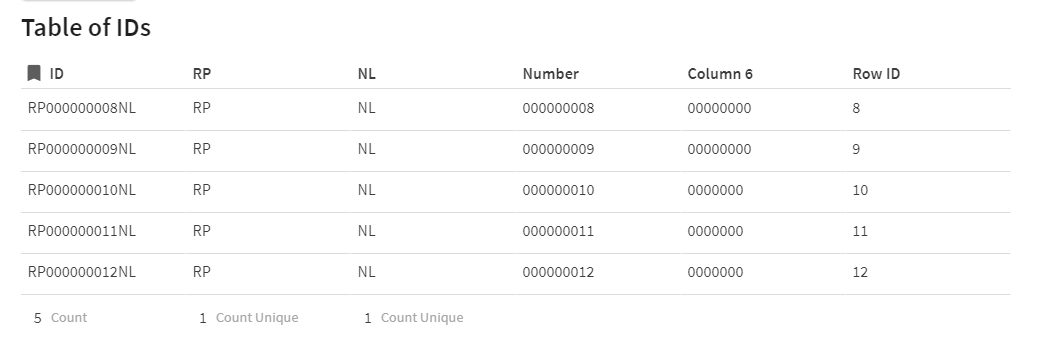Hey,
I am trying to create a barcode like this one: [RP179349376CN]

As you can see in below table, when going from 9 to 10, an additional digit is added.
My question is how to guarantee the digits used are always the same amount? (the reason in column 6, I deducted manually a zero)
Looking forward to learn from your know how 
Best,
//JP
LeftPad would do the trick, I think. Do you know in advance how many rows you will potentially have, or is it completely dynamic?
If you know, it’s just LeftPad([Row ID], 2, "0").
If you don’t, you’ll have to do something a little more complex, you’ll have to go through all the ‘Row IDs’ to find the longest one, then count the digits, and use this as your target length:
LeftPad([Row ID], [Table of IDs].Sort(false(),[Row ID]).[Row ID].First().ToText().Length(), "0")
Hope this helps!
1 Like
Dear Joe,
The first solution  made it working as expected, thanks a lot.
made it working as expected, thanks a lot. 
In your second proposal, how can I choose the amount of digits, in my case I should like “9”?
Best,
//JP
LeftPad syntax is string, target length, filler, so if you change the second argument, you’ll get what you want, I think (eg: LeftPad([Row ID], 9, "0"))
Joe
Dear Joe,
Yes, that’s how I did it in the first solution. (see screenshot in previous post)
Just for curiosity and to learn, where to set the length in this formula?
LeftPad([Row ID], [Table of IDs].Sort(false(),[Row ID]).[Row ID].First().ToText().Length(), "0")
Thanks for your time,
//JP
Let me break the formula down a bit:
LeftPad(
[Row ID], // This is the string you're going to pad. For example, it might be '1'
[Table of IDs].Sort( // Now I'm going to get the highest Row ID.
false(), // Sort from largest to smallest (DESC)...
[Row ID] // ... by the Row ID column
).[Row ID].First() // Now get the first row of our sorted list's row ID. In a table with 100 rows, this will be 100.
.ToText().Length(), // Now, convert the value to a string, and get the length of the string (eg: 100 => "100", which has length 3.
"0") // Now pad the string with the character 0.
So parsed out as a list of ‘instructions’ to Coda:
- Get a string from the column called ‘Row ID’
- Get the target length of the new padded string by:
2a. Getting the ‘Table of IDs’
2b. Sorting it by the Row ID column from largest to smallest
2c. Getting a list of values from the Row ID column
2d. Getting the first one
2e. Converting it to a string
2f. Getting the length of the string.
- Use the character “0” to pad out the string
- Take the string from step 1, and add the value from step 3 to the front of it until the string reaches the length from step 2f.
Hope this helps!
2 Likes
Dear Joe,
Wow, thanks for the detailed explanation of the formula  , hopefully soon I will be able to reproduce such formulas on my own.
, hopefully soon I will be able to reproduce such formulas on my own.
Best,
//JP
1 Like



 made it working as expected, thanks a lot.
made it working as expected, thanks a lot. 

 , hopefully soon I will be able to reproduce such formulas on my own.
, hopefully soon I will be able to reproduce such formulas on my own.